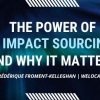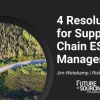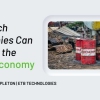Strategic Sourcing in a Hyperinflationary Environment
Maximize value and manage risk in challenging conditions.
Over the past year, growing demand has driven price increases and margin pressures across a wide range of commodities. Since mid-2020, steel, for example, has risen by 85%, lumber by 119%, cotton by more than 20%, and cotton yarn by 35%. Additionally, propelled by a combination of high demand and global container shortages, spot buying rates for freight from East Asia to the United States and Western Europe have jumped by up to 700%.
Not only was this inflationary pressure unforeseen, but it is also the highest since 1992, with no immediate abatement in sight. It is causing major ripples in global supply chains and consequently raising many questions about how businesses should go about both preserving margin while simultaneously de-risking and future-proofing their supply chains.
Our experience across a variety of clients, industries and geographies indicates that although not intuitive, current market volatility actually presents a genuine opportunity for manufacturers, resellers and distributors to actively restructure their supplier relationships in ways that will remedy the short-term margin squeeze, drive significant savings and maintain supply continuity.
Disaggregate Cost Components
When executing strategic sourcing projects (particularly in a period of hyperinflation), achieving visibility into suppliers’ cost structures almost always delivers major insights, which in turn informs negotiations strategies. This involves thoughtfully designing RFPs that require suppliers to disaggregate different cost components of the finished product and to help us understand their individual impact on the total unit cost.
Examples of these cost components include raw materials or commodities, manufacturing, labor, packaging, freight, and duties by subassembly and end product. By differentiating the core, commodity-dependent, standardized components from the value-add, competitively source-able, commodity-independent components, it is possible to paint a clearer picture outlining the cost components that cannot be controlled and highlighting the controllable cost components.
This isolating of components and transparency during competitive RFPs challenges suppliers to sharpen their pencils on the controllable portions of their costs, while having faith that buyers understand certain index-based portions cannot be lowered.
For example, certain fasteners may have 30% of their costs driven by steel prices. Although the raw material price has risen rapidly in recent times, the value-add costs (such as machining, labor, overhead) have not seen much of a knock-on effect.
This also applies to freight, where we are currently seeing major price hikes. Our research shows that manufacturers that were used to paying $2,000 to $3,000 for a 40-foot container are now paying upwards of $10,000.
Disaggregating global market-driven cost components like raw materials and freight helps assure the most advanced negotiations and protections as the market prices swing. It also enables buying teams to zero-in on the value-add portions of unit costs, making price negotiations more targeted and efficient while simultaneously equipping buyers with the tools to future-proof themselves from fickle market conditions.
Review and Rethink Supplier Partnerships
In a typical spot-buying environment, companies switch between multiple suppliers that offer the lowest prices as often as needed. While this practice appears to be cost effective, it fails to solve for market conditions that drive price volatility, and in fact, breeds long-term instability in supplier relationships.
In spot buying environments, buyers receive quotes from suppliers based on the perceived value of their own capacity at that point in time as opposed to receiving preferred pricing consistently by developing deeper supplier relationships.
Challenging market conditions present a valuable opportunity to review and rethink how the supplier base is organized, as part of preferred supplier arrangements designed to leverage scale, assure supply and balance pricing.
Using a competitive and comprehensive process designed to uncover underlying cost components, a small set of preferred suppliers should be identified, based on their prices, quality, capacity, expertise and reliability. The supplier group would then bid for individual purchase orders on a sprint basis. Ideally, preferred supplier arrangements should last at least 12 to 18 months and have clear visibility of total potential and expected volumes.
Firstly, cash flow predictability driven by preferred supplier arrangements will help suppliers to properly plan their capacity allocation across their customers. Secondly, this will enable suppliers to offer dynamic, best-in-class pricing within a tighter range, even accounting for material index movements. Thirdly, by deepening supplier relationships, buyers can, to a great extent, insulate themselves from potential price gouging by suppliers or be prioritized when there are materials shortages, thus building a healthier and more resilient supply chain.
Buyers should also consider developing more local in-market supplier relationships at this time. Depending on the items being procured from third parties, the total cost and demand volatility may have tilted the balance more towards local suppliers. For example, a U.S. food manufacturer that traditionally sourced all its garlic from China is now sourcing from California, thereby mitigating supply risk while keeping its production cost per pound competitive.
By communicating a clear preferred supplier strategy, businesses will send the message that they are committed to working on mutually favorable terms, sharing in the ups and downs. We have found that this approach keeps suppliers engaged, fosters a partnership-based business environment, and maintains fair competition between preferred suppliers.
As another example, a U.S.-based client in the metal component manufacturing and distribution space has been able to better withstand spikes in steel prices by substantially consolidating their spend with preferred suppliers. This has allowed them to remain competitive in the market, improve EBITDA by 4% and ensure supply continuity throughout all of 2021 while many of their key competitors incurred delays and product shortages.
Leverage Market Insights to Optimize Pricing Responses and Margin
In addition to these execution-focused levers, it is also vital for purchasing and sales teams to be closely linked in this highly volatile market. Purchasing teams can strengthen their commodity strategy through use of stronger market intelligence and can reinforce the company’s position by sharing this knowledge and expertise with sales teams.
To this end, we have worked with several clients across industries ranging from highly engineered automotive parts to relatively simple, commoditized items to create a market intelligence cockpit for sales and purchasing teams to consolidate and leverage market knowledge to drive profitable sales.
Final Thoughts
Complexity and change always breed opportunity. In our highly interconnected trade and supply-chain ecosystems, the continuously evolving challenges surrounding hyperinflation will continue to loom, with no abatement in sight at least until March 2022 (best-case scenario).
Designing and executing projects by identifying the right impact levers and developing strategic relationships with a curated list of trusted supplier-partners is a powerful way to turn uncertainty into a tactical advantage and tangible financial benefit.











